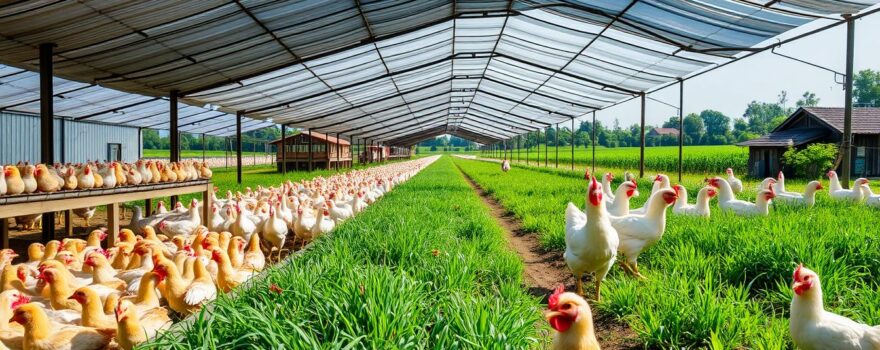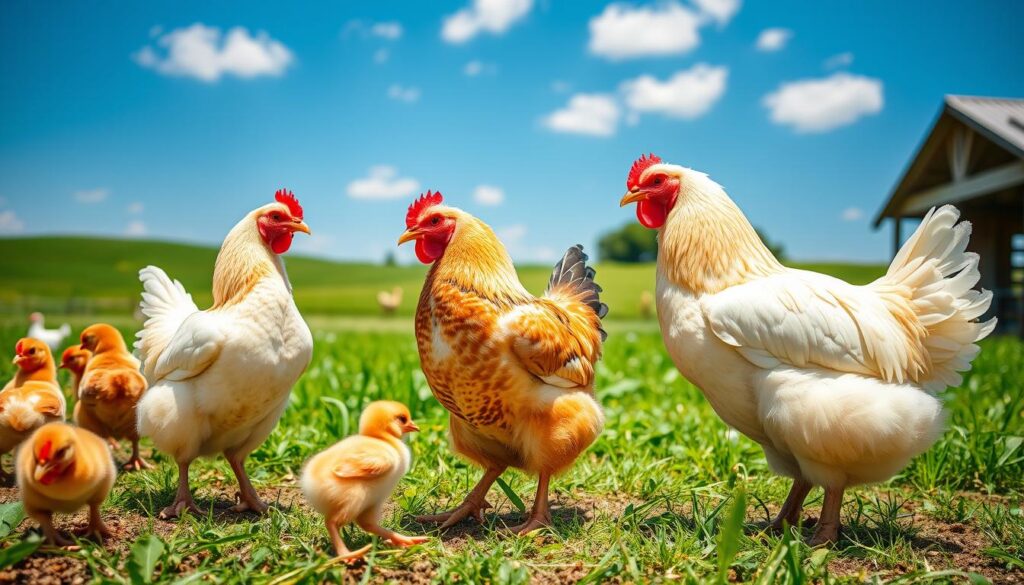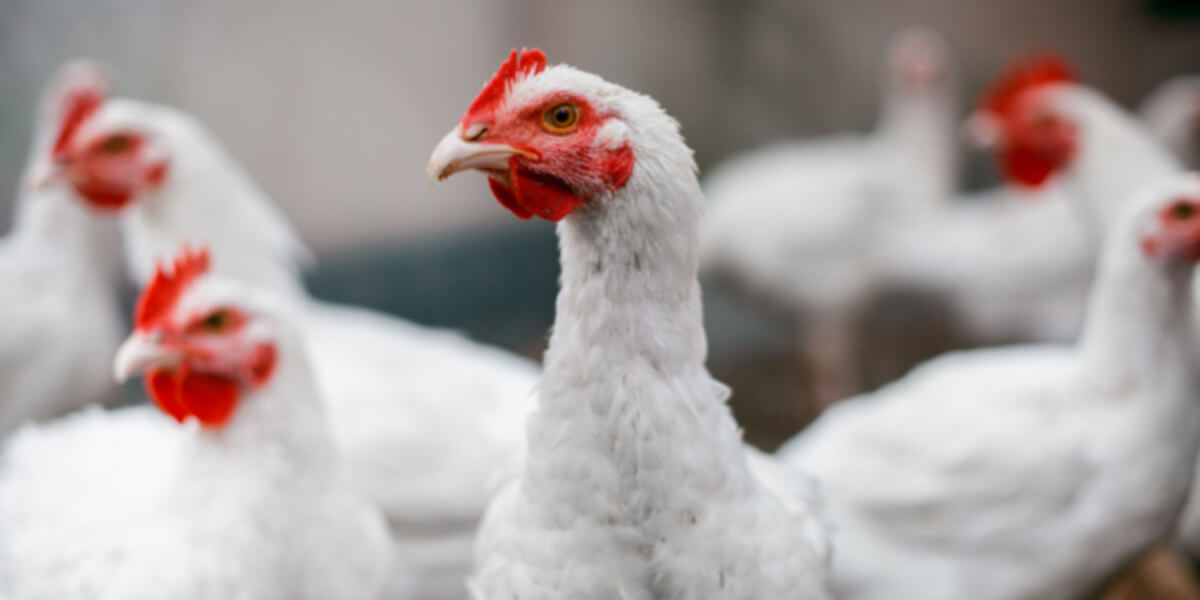
The broiler chicken industry is growing fast, and environmental factors play a big role. Broiler chickens grow quickly and are very sensitive to their surroundings. Changes in weather due to climate change are big challenges for farmers.
It’s important to know how the environment affects broiler chickens. This knowledge helps improve their growth, how well they eat, and keeps them healthy.
The industry has made big steps to reduce its environmental impact. Today, it takes less resources and produces less pollution than before. Water use has gone down, and most chicken waste is recycled.
Using new, energy-saving technologies has also helped. For example, LED lights use much less energy than old bulbs. But, the industry still faces challenges, especially in warm places.
Key Takeaways
- Broiler chickens are highly sensitive to their surrounding environment, with climate change posing significant challenges for modern poultry farming.
- The broiler chicken industry has made substantial progress in reducing its environmental impact, achieving significant reductions in resource usage, greenhouse gas emissions, and farmland utilization.
- Advancements in energy-efficient technologies, such as LED lighting, have contributed to substantial energy savings in poultry production.
- Maintaining optimal environmental conditions is crucial for broiler chickens to achieve their genetic potential for rapid growth and high meat production.
- Understanding the interplay between environmental factors and broiler chicken development is essential for optimizing growth performance, feed efficiency, and disease prevention.
The Impact of Environmental Conditions on Broiler Chicken Growth Phases
Broiler chickens grow and develop based on many environmental factors. These include temperature, humidity, ventilation, and litter conditions. Knowing how these factors affect broiler chicken growth is key to improving poultry production.
Research shows that broiler chickens grow differently based on their genetics. For example, a study of 238 chicks found that Ross 308 chickens grew the most. They also ate the most feed and gained weight the fastest.
| Breed | Final Live Weight | Feed Intake | Daily Weight Gain | Feed Conversion Ratio |
|---|---|---|---|---|
| Ross 308 | Highest | Highest | Highest | Best |
| Bionda Piemontese | Lower | Lower | Lower | Worse |
| Robusta Maculata | Lower | Lower | Lower | Worse |
But, the local breeds, Bionda Piemontese and Robusta Maculata, had better meat quality. They also handled heat stress better than Ross 308 chickens.
Temperature greatly affects broiler chicken growth and meat quality. Higher temperatures can slow growth but improve meat’s fatty acid content. Ross 308 chickens were more affected by heat than local breeds.
Keeping the right environment is vital for broiler chicken growth. This includes the right temperature, humidity, air flow, and litter quality. By understanding these needs, producers can improve productivity and meat quality.
Climate Change and Broiler Production
Climate change is affecting many areas, including the poultry industry. Rising temperatures and changing weather patterns are big challenges for raising broiler chickens, especially in warm places. Broiler farmers must find ways to keep their birds healthy and productive as the weather changes.
Global Warming and Weather Pattern Changes
Global warming is causing weather to change all over the world. We’re seeing hotter temperatures, more unpredictable rain, longer dry spells, and more extreme weather. These changes are disrupting ecosystems and affecting the growth and health of crops and animals, including broiler chickens.
Challenges in the Tropics
Tropical areas are especially hard hit by climate change because of their high temperatures and diverse ecosystems. Raising broiler chickens in these places is tough because of the heat and unpredictable weather. Research shows that heat stress can make chickens eat less, grow slower, and be less efficient, hurting their productivity and the farm’s profits.
To tackle these problems, broiler farmers need to try new approaches and technologies. They can use advanced climate control systems, improve the living conditions for chickens, and look for breeds that can handle the heat better. These steps can help make broiler production more resilient against climate change.
Growth Potential and Limitations of Broilers
The broiler industry has grown a lot in the last 20 years. In 2021, global broiler meat production hit about 121.5 million metric tons. This is a 107% jump from 2000. But, the growth faces big challenges because of climate change, especially in warm areas.
Genetic Traits for Rapid Growth
Broiler chickens have been bred to grow fast and use feed well. They can get to two kilograms or more in just seven weeks. This shows how genetics have helped the industry grow.
Impact of Unfavorable Environments
But, the changing climate is a big problem. High temperatures, more humidity, and different rain patterns in the tropics are bad for broilers. Heat stress can hurt their growth and how well they do their job. It can even cut their performance by up to 36%.
The broiler industry also has a big carbon footprint. It includes emissions from meat processing, shipping, manure, and feed. As the industry grows, especially in new places, it must find ways to deal with climate change. This is key for sustainable and efficient broiler production.

“Continuous and cyclical heat stress can decrease broiler performance by 36% and 21%, respectively.”
Feed Scarcity and Cost Implications
The poultry industry is facing big challenges because of climate changes. Rising temperatures and unpredictable weather hurt crops and livestock. This is especially true in the tropics, where chicken farming is very affected.
Research shows that a chicken needs 1.5 kilograms of feed to grow 1 kilogram. The move to slower-growing chickens is gaining ground in Western Europe. But, this change worries about the environment, like more land use and energy use.
| Metric | 2012 Value |
|---|---|
| Average cost per ton of feed for broiler chickens | $347 |
| Average feed cost per pound of broiler meat | $0.31 |
The Greenwell project looked at sustainability in chicken farming from 2017 to 2022. It studied data from many farms and slaughter lines. It compared regular chickens, fast-growing chickens, and free-range chickens. But, it didn’t include organic chickens because of a lack of data.
The poultry industry needs reliable and cheap feed to keep chickens growing. Climate changes make this hard. The industry must find new ways to keep chicken farming sustainable.
Thermal Stress and Heat Management
Climate change has made it harder for broiler chicken farmers. Rising temperatures and humidity cause thermal stress in these birds. In tropical areas, heat stress hurts growth, productivity, and health. Farmers use cooling systems and other methods to fight this.
Evaporative Cooling Systems
Evaporative cooling is a key solution for broiler chickens. It lowers air temperature by using evaporation. Water in the air cools the area, working best in dry climates.
Alternative Cooling Methods
- High-temperature sprinkler cooling: This method involves periodically spraying water over the birds’ feathers, creating a cooling effect through evaporative heat loss.
- Ventilation and air circulation: Proper ventilation and air circulation within the poultry house can help distribute cooler air and promote heat dissipation.
- Reflective and light-colored surfaces: Using light-colored or reflective materials on the poultry house surfaces can reduce the absorption of radiant heat from the sun.
- Bedding management: Maintaining clean, dry bedding can help minimize the release of additional heat from stagnant feces.
These cooling strategies help farmers create a better environment for their birds. This supports better growth, feed efficiency, and production.
Impacts on Broiler Immune Function and Disease Susceptibility
The broiler chicken industry is facing big challenges. Climate change is affecting their health and productivity. Environmental stressors can weaken their immune system, making them more likely to get sick.
Studies show that broilers are most vulnerable between days 6 to 13 after hatching. But, their immune system peaks between days 30 to 34. This means their immune system takes time to fully develop.
Fast-growing broilers are naturally less resistant to diseases. High temperatures, humidity, and crowded living conditions can make things worse.
To help broilers stay healthy, nutrition and management are key. Understanding how climate change affects their health is important. This way, producers can keep their flocks well and productive.
“The immune system of broiler chickens does not mature until days 30 to 34, leaving them vulnerable to pathogens in the critical early growth stages.”

Broiler Production and Greenhouse Gas Emissions
The broiler industry is big in the global food system. The United States leads, producing about 20% of the world’s chicken. But, it also has a big environmental impact, adding a lot to greenhouse gas emissions.
Carbon Footprint of Broiler Industry
The main cause of the broiler industry’s carbon footprint is feed production. It makes up 65-80% of the emissions, energy use, and health effects. The rest comes from fuel, manure, and farm activities.
Emission Sources and Mitigation Strategies
Scientists are finding out where the emissions come from. They’re looking for ways to lessen the broiler industry’s impact. Using renewable energy, improving feed efficiency, and better manure management are some strategies.
Changing what and how feed is made can also cut emissions. By using these methods, the broiler industry can be more sustainable. This helps in the fight against climate change.
| Sustainability Metric | Conventional | Dutch Retail Broiler | Better Life one Star |
|---|---|---|---|
| Land Use (m2a crop eq) | 3.59 | 4.00 | 4.32 |
| Phosphorus Excretion (g P excreted) | 3.02 | 3.80 | 5.01 |
| Climate Change Impact (kg CO2-eq, excluding LUC) | 1.38 | 1.58 | 1.75 |
| Climate Change Impact (kg CO2-eq, including LUC) | 3.75 | 4.07 | 3.64 |
The table shows how different broiler systems affect the environment. It points out the importance of feed, land, and manure in the industry’s carbon footprint.
Sustainable Broiler Production Practices
The broiler chicken industry is working hard to be more eco-friendly. Farmers are using new ways to save resources and cut down on environmental harm. They focus on saving water, making feed go further, and managing nutrients from manure.
Water Conservation
Water is key in broiler farming, and farmers are finding ways to save it. They use smart watering systems and recycle water for cleaning. This helps reduce water waste and saves water during the birds’ growth.
Feed Efficiency and Nutrient Management
Feed efficiency is vital for sustainable broiler farming. Farmers are tweaking feed recipes to use less and waste less. They also have plans to use broiler litter and manure wisely, avoiding pollution.
These efforts make broiler farming better for the planet. They help lower the industry’s carbon footprint. This is good for the future of poultry farming.
| Sustainable Practice | Key Benefits |
|---|---|
| Water Conservation | Reduced water consumption, improved water use efficiency |
| Feed Efficiency | Reduced feed waste, lower environmental impact of feed production |
| Nutrient Management | Responsible utilization of broiler litter and manure, prevention of nutrient runoff |
“Sustainable broiler production is not just about environmental responsibility, but also about ensuring the long-term viability and competitiveness of the poultry industry.”
Economic and Policy Implications
The broiler industry faces big economic implications and policy implications. Rising feed costs and more energy use are big issues. Also, meeting environmental standards is a challenge. To keep the industry going, we need good policies and incentives for sustainable practices.
The U.S. broiler industry is key to our agriculture, making 27 billion kg of broiler live weight in 2021. It’s worth over 31 billion dollars and creates over a million jobs. But, it’s growing slower and needs more investment and better management.
Feed costs are a big problem, making up a lot of the expenses. To be more sustainable, the industry must find ways to use feed better. Governments can help by supporting new feeding methods and sustainable feed sources.
| Metric | Baseline Case | Renewable Energy | Sustainable Corn | Low-GHG |
|---|---|---|---|---|
| Net Present Value ($/bird) | 0.96 | 1.01 | 0.99 | 0.97 |
| Operating Cost ($/bird) | 1.90 | 1.85 | 1.88 | 1.91 |
| GHG Emissions (kg CO2-eq/bird) | 2.73 | 2.34 | 2.66 | 2.24 |
The table shows how different broiler production methods compare. It highlights the balance between making money, keeping costs down, and reducing emissions. Finding the right policies is crucial for the industry’s future.
In summary, solving the broiler industry’s sustainability issues needs teamwork. By tackling the economic and policy challenges, we can keep the industry strong and vital to U.S. agriculture.
Adaptation Strategies for Broiler Farming
The broiler industry is facing big challenges from climate change. It’s working hard to find ways to make broiler farming more resilient. This includes improving genetic selection, breeding programs, and using new technologies in precision livestock farming.
Genetic Selection and Breeding Programs
Poultry breeders are creating broiler strains that can handle tough environmental conditions. They focus on breeding birds that can better handle heat, fight off diseases, and use feed efficiently. This way, the industry can grow birds that stay healthy and productive, even when the weather is harsh.
Precision Livestock Farming and Technology
The broiler industry is also using advanced technologies to manage the environment better. These include systems for controlling temperature, humidity, and air flow, as well as tools for monitoring health and performance in real time. By using this technology, farmers can create the best conditions for their birds to grow, reducing the effects of climate change.
It’s vital for the broiler industry to adapt to changing climates to stay sustainable. By improving genetics, breeding, and using new technologies, the industry is getting stronger. This ensures that people around the world can keep enjoying high-quality poultry products.
“The broiler industry’s ability to adapt and innovate will be key to its success in the face of climate change.”
The environmental impact of broiler production is a big challenge. It involves understanding climate change, resource use, and industry practices. The industry is working hard to find sustainable solutions for broiler farming.
By focusing on climate change effects on broilers, the industry aims to be more environmentally friendly. This includes improving feed, managing stress, and reducing emissions. These efforts are key to making broiler farming sustainable for the future.
The broiler industry is leading the way in adapting to climate change. It’s working on sustainable food production for the future. Despite growth in chicken meat production, the industry must focus on reducing emissions.
Advances in genetics, precision farming, and emission reduction are crucial. These will help the industry meet global demands while protecting the environment. This way, broiler production can be a sustainable source of protein for all.